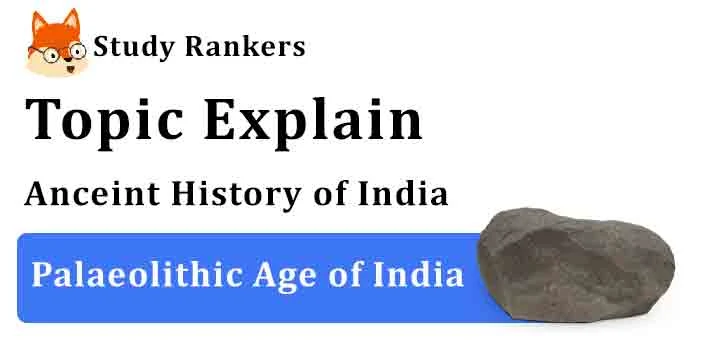Palaeolithic Age of India - Ancient History of India
This article is about Palaeolithic Age of India which is very beneficial for UPSC, SSC, NET and other competitive exams. This topic is a part of Ancient History of India in which we will see Stone age of India and its three divisions, lower Palaeolithic, middle Palaeolithic and upper Palaeolithic age of India. It will help you in developing your knowledge and perform better in the exams.

The Paleolithic culture or Old Stone Age of India developed in the Pleistocene period or the Ice Age. The environments of the Pleistocene period were cold and dry and the surface of the earth was covered mostly by ice. The Pleistocene period comes immediately before the geological period called Holocene period, period in which we live that began about 10,000 years ago.
• The term “Pleistocene” was first coined by the nineteenth century British geologist Sir Charles Lyell. The origin Greek words are “pleistos” and “kainos” . ”Pleistos ” mean “most” and “kainos” mean “new” or “recent”. Thus, the term mans “the recent period”.
• The term “Holocene” formed from two Greek words are “Holos” and “kainos” . ” Holos” mean “wholly” and “kainos” mean “new”. Thus, the term mans “the wholly or entirely new period”.
In India, the Palaeolithic age continued from the appearance of human beings in the region till about 9,000 BC.
In India, the Palaeolithic age continued from the appearance of human beings in the region till about 9,000 BC.
The Palaeolithic people were nomadic and did not know how to build houses. They lived in their natural habitat, such as in caves. The Palaeolithic people wore animal skin, barks or leaves to protect their bodies from harsh weather conditions. They used tools made of crude stones and animals’ bones which are served the purpose of cutting and boring.
During this period, Civilization was not developed in the Palaeolithic period. The Palaeolithic people had the knowledge of painting as Hunting scene was most common in Palaeolithic painting. The most common painting of Palaeolithic period is in Bhimbetka, Madhya Pradesh.
The crude stones used to make Palaeolithic tools were cut from a hard rock called “Quartzite”. Therefore, the people of the Palaeolithic period in India are known as “Quartzite men”.
Palaeolithic tools have been found in the Kurnool district (in Andhra Pradesh) and in the Belan valley (Mirzapur district in Uttar Pradesh). In the Belan valley, bone implements and animal remains have also been found along with stone tools. No Palaeolithic sites have been found in the alluvial plains of the Indus, the Ganga and the Yamuna rivers.

The Palaeolithic period in India was very long, historians have divided the period into three parts:
- The early or lower Palaeolithic (around two million years ago and upto 60,000 years ago)
- The middle Palaeolithic (about 1,00,000 and 40,000 years ago)
- The late or Upper Palaeolithic (from 40,000 years ago to 9,000 BC)
The early or lower Palaeolithic Period
Sites of the Early Palaeolithic period have been found in the Sohan valley (in West Punjub, which is presently in Pakistan), the Narmada valley (in Madhya Pradesh, Maharashtra and Gujarat), Didwana (in Rajasthan), Bhimbetka (near Bhopal in Madhya Pradesh), Kashmir and Thar Desert.
The tools were all made by removing flakes from a block or core of stone in the required size and shape. It includes hand axes, cleavers, chopping tools, and related artefact forms.
The Geological Age of Early Palaeolithic period is the lower Pleistocene Period.
Read about Early or Lower Palaeolithic Age.
The middle Palaeolithic Period
• Middle Palaeolithic sites have been found in the Sohan valley , The Narmada valley , Didwana , Bhimbetka, Begor and the Karmali valley(both in Rajasthan), and nevesa (in Maharashtra).
• Hand axes, Choppers and Cleavers were still continued but small and light flake tools were mostly used. The most important tools includes blades, points, borers, scrappers, cores and burins.
• The Geological Age of Middle Palaeolithic period is the middle Pleistocene period.
The late or Upper Palaeolithic Period
• The sites of the late Palaeolithic period have been found in the Belan valley, Bhimbetka, Begor, Renugunta(in Andhra Pradesh), and Singhbhum(in Jharkhand), Buddhapuskar (in Rajasthan).
• The people used tools that include wide range of scrapers, backed blades, points, choppers and burins, and also blade technology.
• The Geological Age of the Late or Upper Palaeolithic period was the Upper Pleistocene Period.
The middle Palaeolithic Period
• Middle Palaeolithic sites have been found in the Sohan valley , The Narmada valley , Didwana , Bhimbetka, Begor and the Karmali valley(both in Rajasthan), and nevesa (in Maharashtra).
• Hand axes, Choppers and Cleavers were still continued but small and light flake tools were mostly used. The most important tools includes blades, points, borers, scrappers, cores and burins.
• The Geological Age of Middle Palaeolithic period is the middle Pleistocene period.
The late or Upper Palaeolithic Period
• The sites of the late Palaeolithic period have been found in the Belan valley, Bhimbetka, Begor, Renugunta(in Andhra Pradesh), and Singhbhum(in Jharkhand), Buddhapuskar (in Rajasthan).
• The people used tools that include wide range of scrapers, backed blades, points, choppers and burins, and also blade technology.
• The Geological Age of the Late or Upper Palaeolithic period was the Upper Pleistocene Period.

